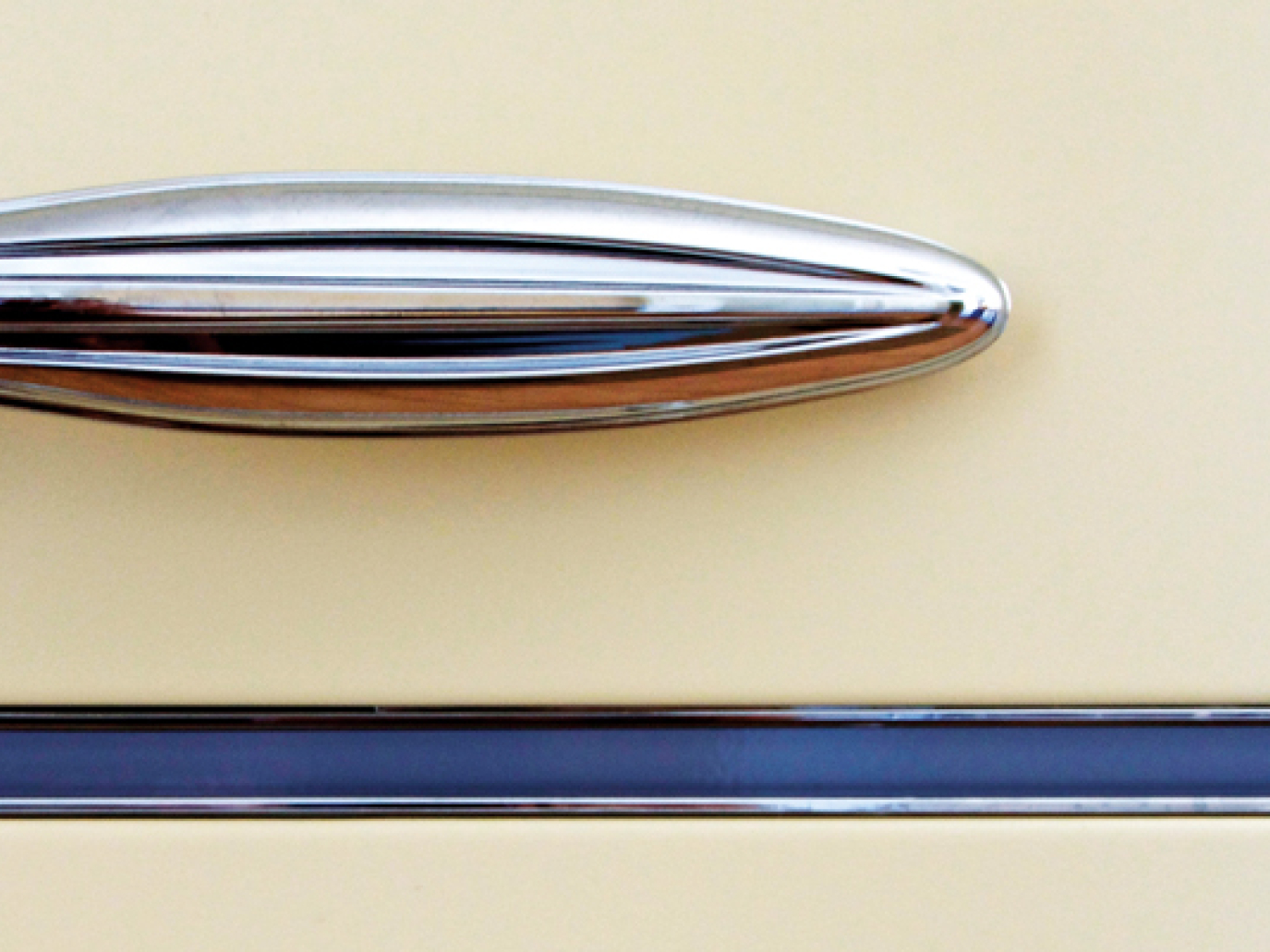Over the last decades, the functionality of the home refrigerator has remained pretty much the same: a big cold box with a temperature between 4 and 7 °C, in which you store all food products you can’t keep at room temperature. And although there have been important technical developments in the field of energy efficiency and refrigerants, its core functionality basically remained unchanged. In approximately 90% of the European households the home refrigerator still is that same 180 litre cold box. But despite this cold storage, many fresh products are spoiled or have lost their freshness by the time we take them out of the fridge for consumption. In the European Union consumers purchase 485 Mt food, of which 84 Mt (17%) is wasted and of which 52 Mt (11%) is avoidable. Triple this amount of raw products is necessary to produce this food, so all-in-all we are talking about 156 Mt of raw products that are wasted but could have been avoided. How can refrigerators contribute to the reduction of avoidable food waste if we redefine their core function? Instead of providing a 180 litre storage facility at a low (4-7 °C) temperature, the fridge becomes a storage facility for the purpose of keeping fresh food products in optimal shape for as long as possible.
Impact of food waste
The study “Optimal food storage conditions in refrigeration appliances” that was published on February 2017, investigated the total EU food flows, their environmental impacts and the effects optimised storage conditions can have on food waste reduction in households. Households play a major role in preventing domestic food spoilage. In the European Union we waste about 160-170 kg/capita per year. This is almost 20% of our food purchases. Of course there are those inevitable bits like bones, peels or kernels, but all-in-all more than half can be avoided. The impact of food and especially food waste is enormous.
When talking about waste, many people tend to make a big fuzz over – for instance – waste and recycling of fridges, electronics and other energy-related products (ErP), but actually this is peanuts compared to food waste. In total 155 Mt of food is wasted in the EU, of which 71 Mt in the process and retail chain, and 84 Mt in the households. This is more than all the waste that occurs during production and end-of-life disposal of all regulated ErP’s, which is only 29 Mt. For ErP’s the waste during use-phase – mainly combustion waste – is the most important (see figure 1).
Looking at energy consumption, the annual production of 485 Mt of food requires 283 Mt of oil equivalent, which is about 17% of EU-total energy use. The greenhouse gas emission for food production represents 1,071 Mt of CO2eq, which is around 25% of the EU total greenhouse gas emissions (see figure 2). And finally household expenditure for food is more than four times the total average annual expenditure on energy and appliances. In short, if we can find ways to avoid the avoidable waste in food consumption, the gains in terms of energy, greenhouse gas emissions and money are significant.
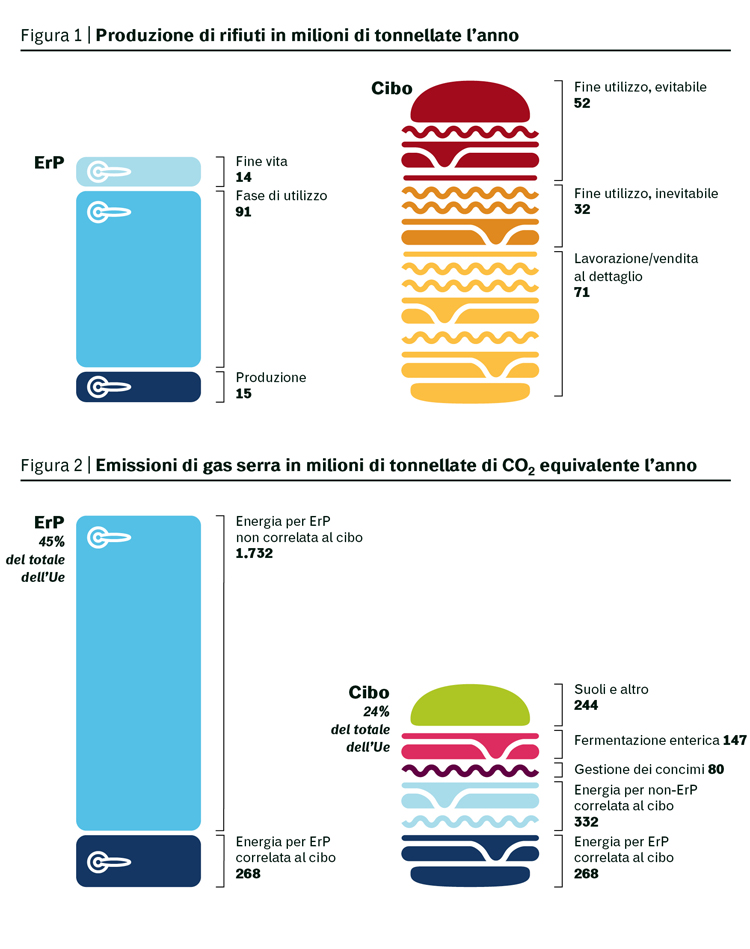
Tools for change
Currently the fight against food waste at consumer level is mainly focussed on raising awareness and trying to change consumer behaviour. Although these are essential aspects, behavioural change is one of the most difficult transformations to accomplish and generally demands a lot of effort, commitment and self-discipline from the consumer. Furthermore not all strategies for behavioural change are applicable to everyone. They need to be tuned to individual possibilities. Increasing shopping frequency, for instance, and buying only what is needed for a short period of time could be a useful strategy for people with enough spare-time, but for households that only shop once a week this is not a feasible option. In all cases it would be advantageous to have an adequate tool that directly interacts with the consumer when he stores his fresh food products and gives guidance on how the various products can best be stored. A refrigerator with improved storage conditions and matching instructions can be such a tool, because it prolongs storage periods and provides more time for consumers to use their fresh food.
Nowadays over 85% of domestic fridges have a single fresh food compartment at a temperature of between 4 and 7 °C, depending on the setting of the thermostat. For about half of the fresh food (and drinks) bought by households, this temperature is either too warm or too cold for best fresh food storage. Figure 3 gives an estimation of the current average storage practice of food and drinks in EU-households.
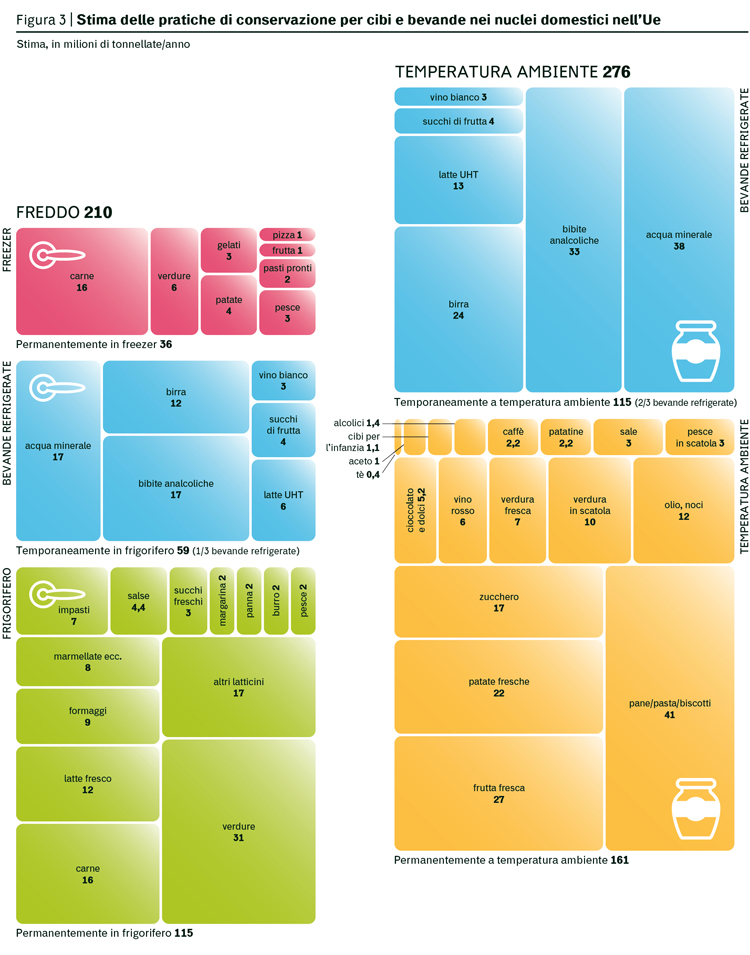
Estimations show that two-thirds, 326 Mt out of 485 Mt food and beverages purchased, is either permanently stored in fridge or, for beverages, at least chilled prior to serving.
How to improve
What causes products to lose quality or become spoiled? Optimal storage conditions are conditions under which the deterioration process of fresh food products is slowed down, and under which food remains in good shape for as long as possible. There is a wide range of physical, chemical and microbial factors affecting food quality, spoilage and safety.
For storing fruits and vegetables three main factors are important: temperature, humidity and ethylene. Ethylene is also known as the “ripening hormone” emitted by ripening fruits (except e.g. grapes, citrus fruits, cherries). Fruits emitting ethylene can onset the ripening process of other fruits and cause leaf yellowing or brown spots on vegetables. A high relative humidity (of minimum 90%) is required to prevent moisture loss and – as a result – water soluble vitamins like vitamin C. The optimal storage temperature varies per type and, for most fruits, per stage of maturation (ripe, unripe).
Take tomatoes for example: Stored at low temperatures (<12 °C) for around 2 weeks they develop symptoms of chilling injury including irregular colour development, softening of tissue or even failure to ripen. When tomatoes are stored at even lower temperatures, these symptoms develop faster: after 6-8 days at 4-5 °C. Tomatoes are so-called “chilling sensitive” (sensitive to low temperatures above 0 °C) as are many other fruits and vegetables. If you wish to ripen your tomatoes a storage in the pantry (17 °C) is ideal. To expand their storage time and somewhat delay the ripening process, storage in the cellar (12-14 °C) is best. Generally speaking, the higher the temperature the faster fruit ripens.
Meat and fish products on the other hand are not chilling sensitive and are best kept around -1 °C to keep microbial growth and discolouration (browning of red meat) at a minimum. Out of all food products, products of animal origin are most often involved in foodborne illness and therefore lowering the storage temperature would definitely benefit consumer health. Most dairy products are well kept at current temperature of 4 °C. However, cheeses are better stored at temperatures around 1-2 °C and eggs can even be kept at -1 °C.
As consumer you do not want to worry about all these things. Clearly many of the safety and storage issues are already covered by food safety regulations and quality assurance guidelines in the food sector. What you can do as consumer is to keep products in optimal shape after purchase, by applying the correct storage practice. All that is needed is a proper fridge and concise storage instructions.
Extended shelf life
When investigating the optimal storage conditions of all fresh products, it was found that by offering five different temperature zones and fitting all fresh products in one of these zones, food storage periods for certain food stuffs can significantly be extended.
The following five temperature compartments were defined:
- 1. -1 °C for meat, fish and eggs;
- 2. +2 °C for lettuce, certain vegetables, certain fruits but also cheese;
- 3. +4 °C a general fresh compartment for milk, yoghurt and butter;
- 4. +12-14 °C for citrus fruits, potatoes, tomatoes, onions, bell pepper, courgettes and aubergines;
- 5. +17 °C for quicker ripening of tomatoes and some fruits.
This implies that four more storage options for food would be necessary besides the standard 4 °C and -18 °C. Table 1 gives an overview of the best fit for fresh products to maximize storage periods.
When products are stored under these improved conditions, their storage periods can be prolonged. Of course the maximum prolongation very much depends on the way the fresh products were handled in the supply chain, but as an estimate an increase of the storage period is expected by a factor of around 2 to 3. Figure 4 shows the expected storage times of various fresh product groups.
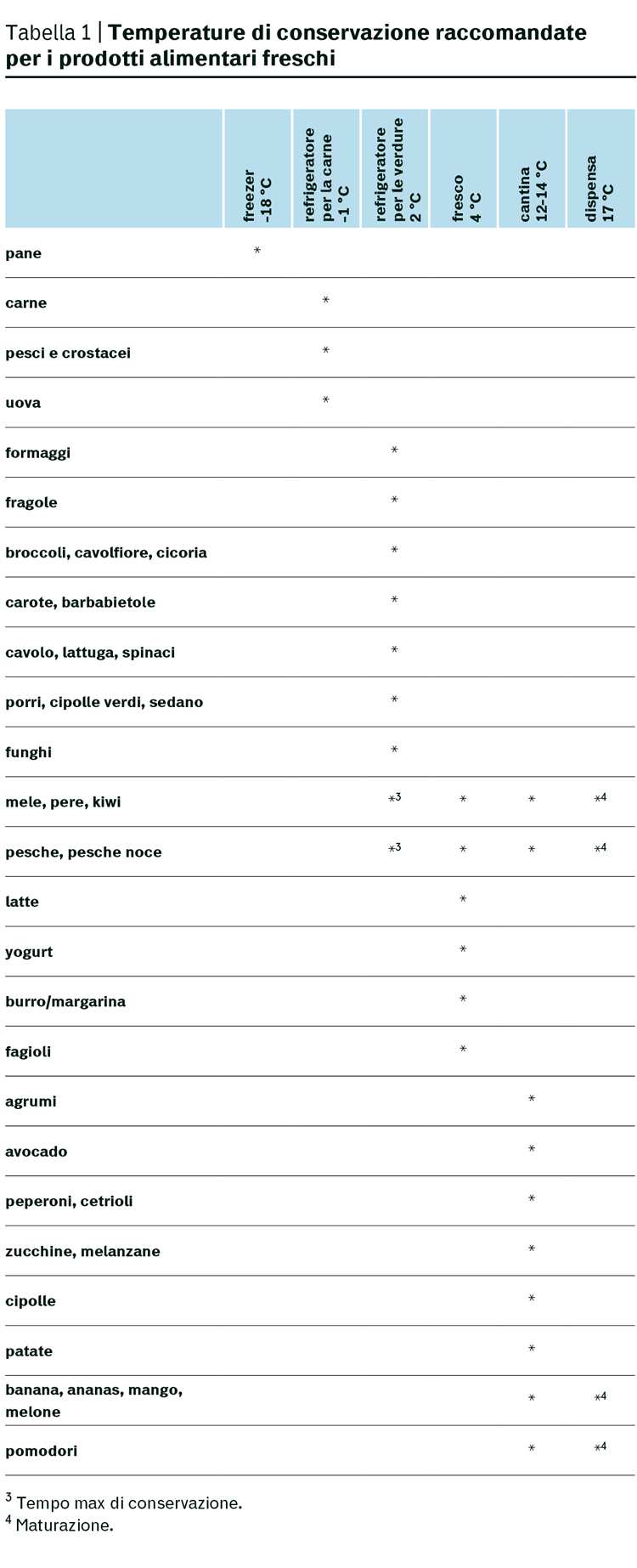
Storage volumes
Do we need larger refrigerators if more fresh products are to be stored in the new multi-compartment fridge? Currently the average single compartment fridge of 180 litre has an average occupied volume of 37 litres, when related to the average shopping frequency and fresh products that are purchased; somewhat more directly after shopping and somewhat less just before purchase of new fresh food products. In other words, without including leftovers and sauces, around 20% of the fridge is occupied with fresh food. The storage volume of a “food-optimised” fridge will probably slightly increase to 27% occupied space, as products previously stored at room temperature will now be stored in the pantry or cellar compartment (see figure 5).
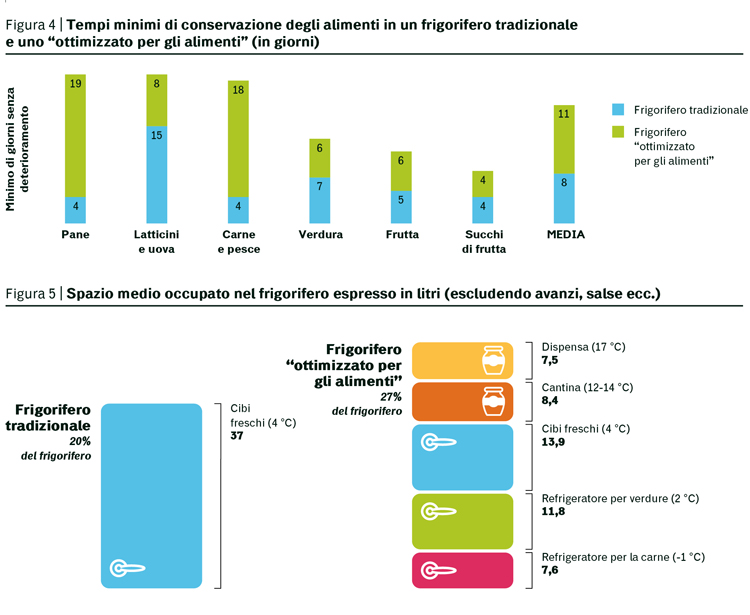
The occupied space for fresh food would increase from 37 to around 49 litres, and in theory this would also mean that the new multi-compartment refrigerator consumes more energy, when all other parameters remain equal. But today’s fridge is – even taking into account peak usage – more than two times oversized. On average, the contents occupy only a quarter of the available refrigerated space. The existence of several different compartments within a fridge, at different temperatures, creates new energy saving opportunities, e.g. from cascading and re-using “waste cold” from defrosting.
All in all, it is considered achievable to reduce a significant share of the avoidable food waste by using multi-compartment refrigerators, without increasing its energy consumption.
Removing obstacles
It is clear that many food products are currently stored under suboptimal conditions. A “food-optimised” fridge with multiple temperature compartments can improve storage and help consumers reduce food waste. To get there, some obstacles need to be addressed on the following subjects:
- fridge design;
- Ecodesign and Energy labelling;
- setting of expiration dates.
As regards the design of a “food-optimised” refrigerator, the EU market will have to move away from the single-temperature fridge. Some brands have developed fridges with special fresh produce drawers or chiller drawers for vegetables and meats respectively. These R&D efforts can be further extended and the energy performance of multi-compartment refrigerators can be further improved. Multiple compartments are necessary to truly meet the needs of the variety of fresh products. In a practical design, the cellar and pantry compartments could probably be divided internally and have a single door. The same goes for the fresh food and salad chiller compartments. The meat chiller, carrying the most valuable food resources (meat and fish), would warrant a separate door. Together with the freezer, a compact design would feature four outer doors.
However, existing legislation on Ecodesign and Energy labelling penalizes multi-doors fridges by not taking into account inherently larger door-leakage energy losses than a single-door refrigerator. Policy makers should allow a multi-door correction factor for refrigeration appliances.
Thirdly, the full food waste saving potential cannot be reached if the expiration dates on food products are not being revised. Harmonisation at EU-level of (parts of) setting “use-by” and “best-before” dates is recommended. For instance, comparable to today’s food labelling for frozen products, the use-by dates for meat and fish could differentiate between storage at +4 °C (traditional refrigerator) and -1 °C (meat chiller).
In conclusion, with supporting legislation multi-compartment refrigerators can become the perfect tool for households to reduce a significant portion of their current amount of avoidable food waste. In potential, the food optimised refrigerator can save more megatonnes of waste than is generated by all the energy related products that are regulated by the ErP-Directive.
Source of all charts and tables: Kemna R., Holsteijn F. van, Lee P., Sims E.. Complementary research on household refrigeration – Optimal food storage conditions in refrigeration appliances, VHK in collaboration with Oakdene Hollins for the European Commission, Brussels, February 2017.
Info


